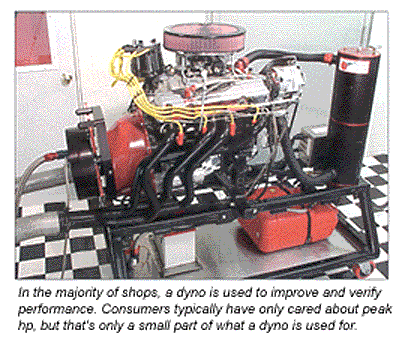To many consumers, dynamometers (flow benches and CNC porting too) represent black art. They believe that dyno testing their engine will somehow magically transform it into a producer of unheard levels of power. Others just want to compare their engine to one they read about in a magazine. And still others are seeking bragging rights. It’s only human nature to want to brag about what you have: bigger is always better.
In the majority of engine shops, a dynamometer is used to improve the products, verify the performance and quality of the engines produced, and in the case of many chassis dynos, troubleshoot drivability issues and emissions calibrations.
On one side of the counter, the consumer often has no understanding of dyno testing in general. If he thinks he does, and is looking for bragging rights or trying to compare his engine’s performance to another, he usually doesn’t understand that the numbers he gets may not be directly comparable to those recorded by another shop in another part of the world. This enthusiast generally has a fixation on peak numbers, without regard to area under the power curve, driveability, idle quality, emissions or a host of other issues that may make the subject engine completely unusable in his application.
Additionally, he may have no knowledge of the other engine, the procedures used to run the dyno test or the facility the testing was done in, all of which have a bearing on the corrected power levels.
On the shop side of the counter, some shops have a dyno to lend a degree of credibility to their operation, or simply to provide a service they can sell. To others, it’s regarded as a costly nuisance. In many cases, neither of these shops have an appreciation for what the dyno could do for them if used correctly.
Unfortunately, a high percentage of professional engine builders who have and/or operate a dyno, do not understand how to properly test an engine. The result is often improper equipment calibration and inaccurate test data from sloppy test procedures.
Some shops even generate phony numbers to please the customer and/or make their product look better than it really is. But as an executive at one of the leading dyno manufacturers explained to me, “You have to be able to handle the truth, even when you just know that it makes more power than that.”
The impact these shoddy practices have on the industry, is to remind us all that horsepower and torque numbers are highly suspect until the source is known.
For those who do understand, the dyno is a valuable tool that gathers data: nothing more, nothing less. What is done with the acquired data – the skills used in translating data into information, and the use of that information to evaluate the tested engine or component – is, as they say, what separates the winners from the losers. The full value of dynamometer testing is only realized when it is used to this end.
There are a number of myths attached to the science of engine testing. One is that the dyno will tell you what you need to do to make more power, and/or will provide you with the skill to make informed changes. Only experience, study and repeat tests will do that. A dyno can be the single biggest investment you can make in confusion, because they have a nasty habit of showing your best th

Another myth is that a dyno makes an engine work harder than it ever will in the real world. While it is true that a test done fully loaded, at a constant rpm or a step test, will put the engine under a heavier load than if it is tested under acceleration, at full throttle, the cylinder pressures and other related factors are the same or very nearly the same, whether on the dyno or in the vehicle.
The engine doesn’t know what it is driving. The only difference between a constant rpm test, and an acceleration test, is that some of the engine’s developed power is used to accelerate the engine itself and the dyno power absorption unit.
On a chassis dyno, additional power is used to accelerate the rest of the driveline, the wheels and tires and the rollers. The engine still develops the power in the cylinders and applies it through the rods to the crankshaft (rotaries excepted).
The more power required to accelerate the engine and other components, the lower the dyno readings will be. The main issue here would be the duration of each test, and how that compares to how the engine is operated in the vehicle. With the computer-controlled dynos in use today, it is possible to come fairly close to real world conditions.
Back To The Basics
One of the more common misconceptions about a dynamometer is that it measures horsepower. WRONG – it only measures TORQUE and RPM













